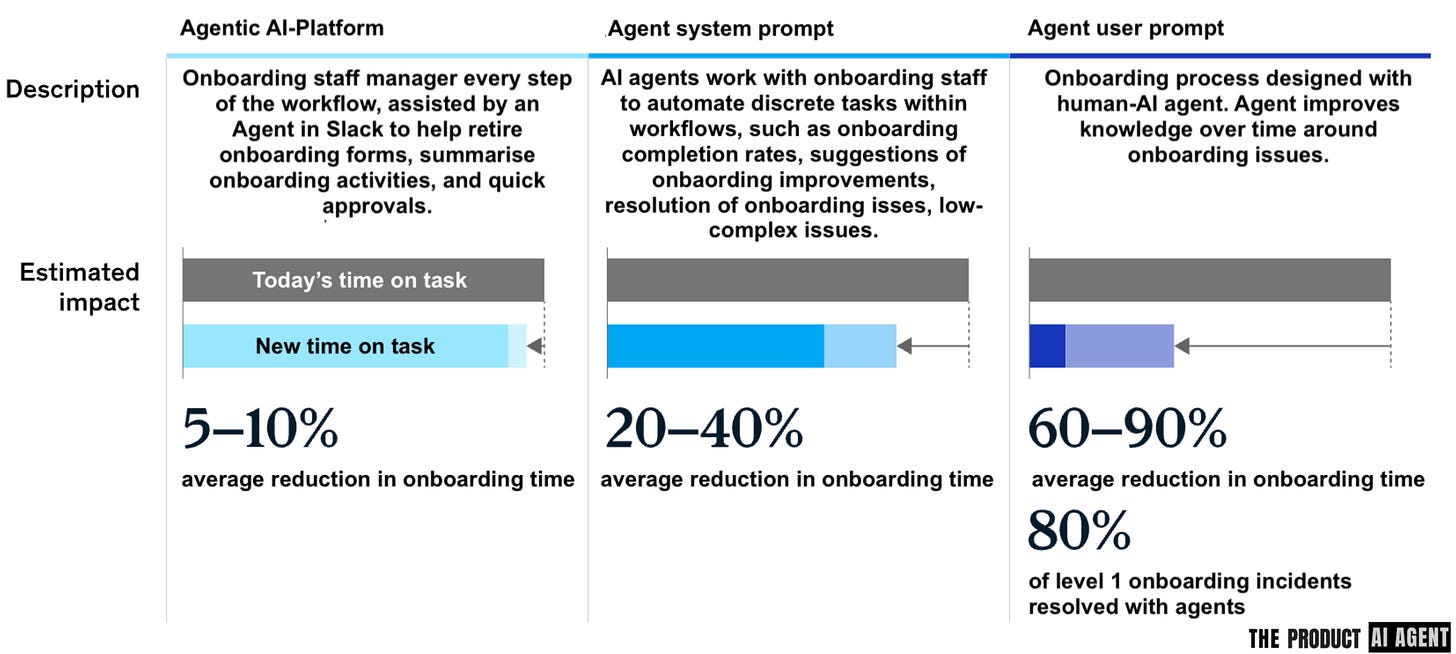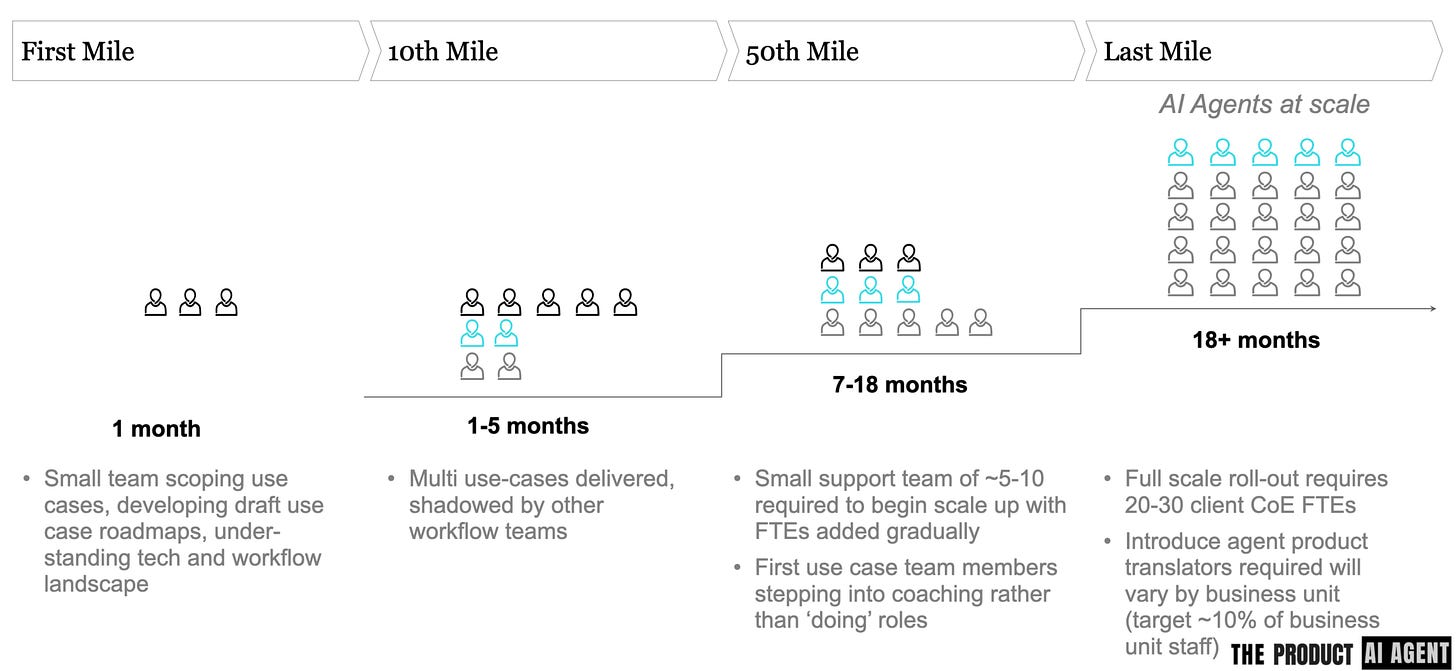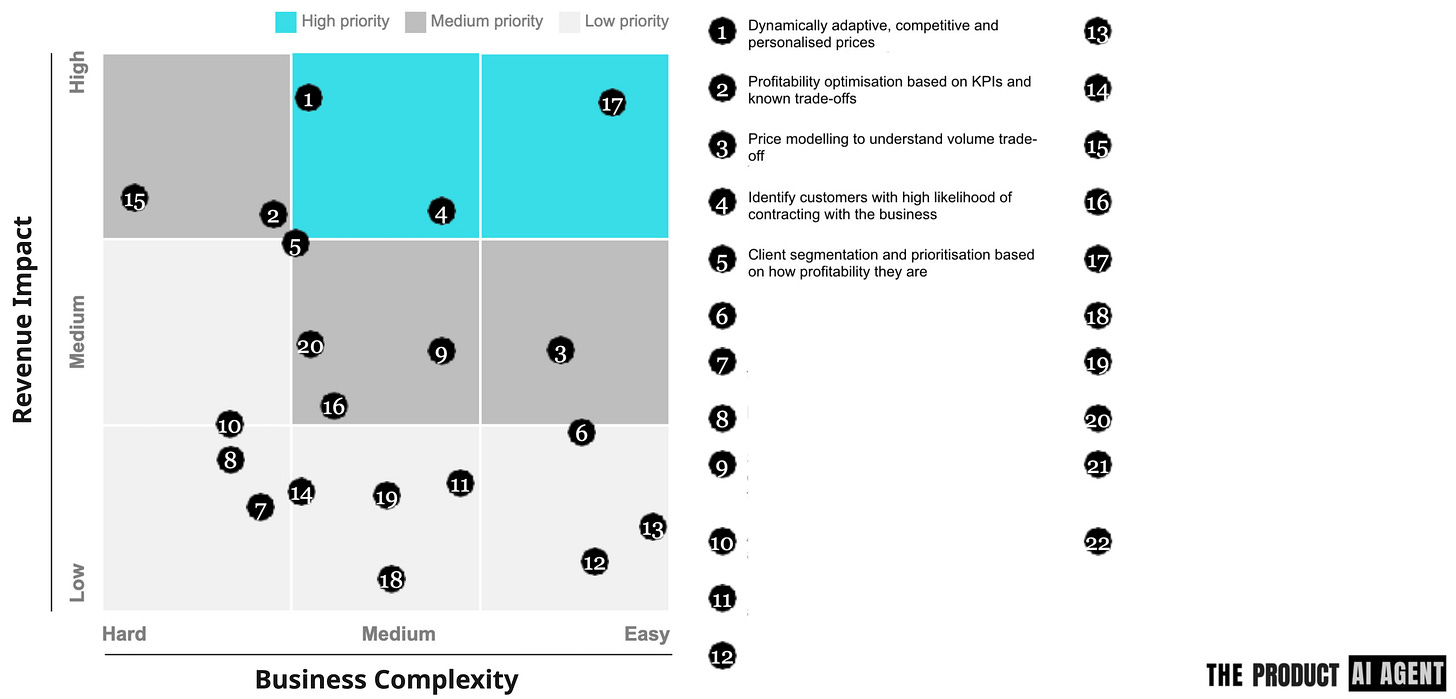Why most AI Agent pitches fail — And 5 Ways yours won’t
How Dot-com crash survivors help us win AI Agent project proposals
A clear pattern is emerging in AI-driven transformations.
The demo impresses. The vision clicks. Executives smile.
Then come the questions about adoption, integration, and measurable outcomes. Suddenly, the answers get vague.
It’s not that AI agents lack potential. It’s that the business case lacks muscle.
This isn’t resistance to innovation.
It’s a rejection born of ambiguity surrounding cost, accountability, change management, and what happens when it goes wrong.
This triggers fear of failure.
Sound familiar? Welcome back to the dot-com boom, 25 years later.
AI agents are being sold like early websites, flashy, speculative, and poorly understood. That’s why they’re joining the 70–80% of AI projects that quietly fail.
If you want to avoid the hype trap and move from demo to delivery, learn to position capability over cool—and become the Salesforce, not the Pets.com, of this next wave.
Let’s break down how to make that leap.
👇 Includes comms slide examples and step-by-step guides to define AI agent value with confidence!
SURVIVAL GUIDE
COMING END JULY 2025!
If you want to ‘Master Agentic AI end-to-end p’ before your competition…..
……enjoy a 50% discount on the ‘No Spoon Survival Guide’.
History repeats itself, the Dot-Com déjà vu
Why does this feel familiar to me?
Because I’ve seen it before during the dot-com era.
Back in 1999, ambitious tech leads pitched the dream of web pages to sceptical executives. It was all “eyeballs” and “IPO narratives”.
No clear revenue model. No operational and business change roadmap.
Pets.com is the poster child.
They spent $20 million on a sock puppet marketing campaign chase “quick growth”, yet failed to build a sustainable, loyalty-driven revenue model.
The puppet became a symbol of dot-com hype (and later, of failure).
When the bubble burst, it wasn’t because websites didn’t work. It was because the transformation into web applications—such as CMS, online payments, and logistics—wasn’t sold as a business transformation.
The parallel with AI Agents is stark.
Teams are pitching agents like plug-and-play enterprise products. Experimental at best, brittle at worst.
“A chatbot that books meetings isn’t an agent.
An LLM wrapper with four prompt stages isn’t orchestration.
Selling a copilot without defining control boundaries, audit trail, or operating model is setting up to repeat the dot-com delusion.”
The real trap?
Selling the wrong value proposition.
Agentic AI is about codifying capability, not just automation.
Many organisations are still stuck in a dot-com mindset:
AI agents are trendy.
They lack a clear strategy to integrate into the business.
They’re lost in buzzwords like “LLMs” and “orchestration”.
The dot-com era ultimately delivered, but only those who built for a real, long-term view and value survived.
“It’s not about having AI agents.
It’s about redefining how the business scales labour and decision-making with AI.”
If you’re responsible for AI transformation, five mindset shifts are needed.
Practice these, and you’ll be on the right side of the conversation transitioning from ‘hype’ to ‘new capability operations’.
5 Mindset Shifts for Winning AI Agent Project Proposals.
Here’s where most people's positioning of AI falls:
They start with flashy, low-code /no-code tools, not capability transformation.
They lead with prompt hype, not business problems.
They dodge risk instead of addressing it.
I use ‘Last Mile Thinking’ to achieve this when using Templonix.
Start where AI needs to end up in scaled workflow operations.
👇 Here’s how to adopt that thinking
1. You’re not selling AI, you’re solving a business problem
Executives don’t care how pretty the prototype is or how clever the technology sounds.
They want results.
Like in the dot-com era, “everyone has an agent (website)” is not a valid reason. (It’s also probably not true!)
Frame the opportunity around business pain, customer satisfaction, and revenue payoff:
“Our customer support wait times are killing our NPS. An AI agent handling Level 1 queries could cut response time from 5 minutes to 30 seconds, improve satisfaction, and save £x in support costs monthly.”
Speak in boardroom outcomes, not feature demos—illustrations like the below help with this:
How to do this with the business:
Start with this bulletproof recipe for working with the executives to tell the story of pain and how it relates to the business problem.
✅ Step 1: Anchor to a real business problem
☐ Pick a metric the exec team already tracks (churn, NPS, cost, SLA)
☐ Ask the business to describe the pain in their own words.
→ “We’re losing revenue because onboarding takes too long.”
✅ Step 2: Quantify what’s broken in the workflow
☐ Map current effort (e.g. time, cost, risk).
☐ Be specific: how many hours, how much money, how many complaints.
→ “8 hrs/week spent on compliance reports = £15K/month in lost time.”
✅ Step 3: Find the person who feels the pain
☐ Identify a business sponsor and the frustrated team
☐ They should be the ones doing all the talking: “If this works, this brings smiles.”
→ Think: CX Lead, Ops Director, Risk Manager
✅ Step 4: Design the agent hypothesis
☐ Define what the agent could do
☐ Decide: what it does, when it escalates, who monitors it.
☐ Describe: compliance and information security challenges.
→ “Agent resolves 80% of queries, escalates the rest with emails to X.”
✅ Step 5: Build the ROI table before the PoC
☐ Fill out a simple before/after table
☐ Focus on time saved, cost reduced, or risk avoided
2. Translate everything into ROI, ditch the jargon
Every line in your AI Agent project proposal should pass the mum test.
If you say:
“Our AI Agent uses GPT-4 and tool APIs to autonomously optimise supply chains.”
You should follow it with:
“Which means we reduce inventory holding costs by 20% and avoid stockouts on high-demand items.”
Executives want “simple language” that translates to business impact, not buzzwords that result in burning budgets. Illustrating this in a simple diagram helps clarify where ROI is achievable, before delving into the details of the complex spreadsheet numbers.
How to do this with the business:
Before embarking on this stage, you should ensure that finance stakeholders are present to provide the Opx and Revenue figures. Communicate in what your mum would understand:
It makes us go faster,
It saves money,
It makes money,
It provides assurance.
✅ Step 1: Replace every capability with a business effect
☐ Ask: “So what does that do for the business?”
☐ Define cause-and-effect outcomes
→ “Auto-generates compliance summaries” → “Reduces audit prep from 8 hours to 1.”
✅ Step 2: Expand the ROI table
☐ Use three columns: Current cost, Target outcome, Metric owner
☐ Tie each capability to time, cost, or assurance
→ If it doesn’t have a measurable impact, it doesn’t go on the slide.
✅ Step 3: Answer the ROI question before they ask it
☐ Ask: “Why now?” and “What do we get from this?”
☐ Use real-world framing:
☐ Tie each capability to time, cost, or assurance
→ “This saves £X per year by replacing [manual task] with [automated outcome].”
✅ Step 4: Translate technical risk into business assurance
☐ Don’t say: “We’ve built a fallback using LangChain agents and model selection.”
☐ Do say: “If the agent's confidence drops below the threshold, we escalate to human review within 30 seconds.”
This makes risk management feel deliberate, not haphazard.
✅ Step 5: Use financial fluency, not technical excitement
☐ Speak in the CFO’s native tongue - margin, cost per task, FTE impact, NPV
☐ Every agent hypothesis should map to a lever on a P&L
→ “Agent reduces manual triage = £240K/year in saved analyst hours.”
3. Name the data risks, then explain the governance
If you avoid the hard questions, someone else will raise them, and the proposal stalls.
In every AI-driven transformation, especially those involving autonomous agents, risk starts with one word.
Compliance, privacy, access, escalation, explainability —these aren’t just technical footnotes. They’re board-level issues.
The mistake? Hoping no one brings them up.
The right move? Raise them early. Show you’ve built for governance, not just capability.
"We’ve designed this agent with a human-in-the-loop checkpoint for all decisions above a defined risk threshold."
Illustrating the transition from a wildcard innovator to a trusted operational thinker strengthens your proposal.
How to do this with the business:
Use clear analogies, plain-language controls, and evidence from pilots to support your claims.
✅ Step 1: Acknowledge the fear out loud
☐ Start with the question everyone doesn’t want to ask:
→ “This agent won’t make decisions above threshold X without human approval.”
✅ Step 2: Map the data exposure areas
☐ Use the workflow map from Section 1 to identify where data is accessed, stored, or passed through systems and tools.
☐ Use data governance standards that the business already employs, and create safe categories if they don’t have them.
☐ Flag what’s in scope and what’s explicitly not.
✅ Step 3: Show the safeguards in plain English
☐ Don’t talk about “LangChain fallback chains”
→ “Every time the agent acts, we log the input, decision, and outcome. If it’s unsure, it escalates automatically.”
☐ Use a control metaphor:
→ “It’s like cruise control. You’re still behind the wheel, and you can brake at any time.”
✅ Step 4. Assign accountability before it’s asked
☐ Define who monitors the agent in production
☐ Introduce an Agent Service Owner role in the workflow
→ This person owns oversight, metrics, and intervention
☐ Explore a live workflow:
→ “Issues are escalated to Ops via Slack with timestamped context and a rollback link.”
✅ Step 5. Share early signals from real usage
☐ Include a snapshot from pilots or internal testing: Error rates, Escalation frequency, Human override cases
☐ Show how those signals led to action
→ “We saw 7% drop in confidence triggers last sprint after tuning the input filters.”
4. Prove use case value fast, then scale with proof
No one wants a big bang rollout. Build trust with small wins.
Suggest a use case phasing plan, demonstrating how to achieve the first mile through a pilot, to provide speed and clarity to leaders that gets them to the last mile.
For example:
“Let’s start with domestic invoices under £5K for 3 months. If error rates drop by X%, we expand.”
This calms nerves and gives you an early win. It also mirrors the Dot-com survivors who tested, learned, and scaled, i.e. Amazon and eBay, rather than betting the company on day one.
How to do this with the business:
Use case prioritisation spells it out for executives: “Here’s what comes next.”
✅ Step 1: Scope for speed, not scale
☐ Choose a use case that’s small enough to deliver quickly
☐ Make it non-critical but meaningful (low risk, visible upside)
→ “Domestic invoices under £5K for 3 months.”
→ “FAQs in one product line only.”
✅ Step 2: Define what success looks like before you start
☐ Pick 1–2 metrics that matter (accuracy, time saved, cost reduced)
☐ Write the success statement in a single sentence
→ “If agent accuracy hits 90% and triage time drops by 50%, we expand.”
✅ Step 3: Lock in a pilot timeline
☐ Set start/end dates and checkpoints (e.g. week 2, week 4, week 8)
☐ Communicate the cadence clearly
→ “Sprint 1: Agent live in test. Sprint 2: Internal use only. Sprint 3: Live with override. Sprint 4: Review + scale plan.”
✅ Step 4. Pre-build the scale path
☐ Show what happens if the pilot succeeds
☐ Include next-phase triggers and what gets rolled out
→ “Phase 2: Expand to international invoices + remove human review on approvals < £2K.”
✅ Step 5. Assign ownership on both sides
☐ Who’s running the pilot day-to-day?
☐ Who signs off on outcomes?
☐ Who owns the decision to scale?
→ Include these names in your pilot brief.
5. Map value with process to show the ‘aha moments’
You’re not proposing a tool. You’re proposing an outcome.
Tailor value to the value drivers impacting the boardroom.
Tailor the agent’s outcome to each stakeholder’s value agenda:
CEO - “This lets us scale without revenue impact.”
CFO - “We’ll reduce operational costs by £500K this quarter with x teams.”
COO - “Faster fulfilment without more headcount.”
Value mapping identifies the complete end-to-end challenge the boardroom faces and guides them in identifying where to scope the ‘quick wins’ and the ‘long-term play’.
How to do this with the business:
This approach helps you achieve the objectives, scope, and deliverables for the agent project.
✅ Step 1: Identify who you need in the room (or who matters most)
☐ CEO? COO? CFO? Functional leads?
☐ Note their core priorities (growth, margin, productivity, retention)
→ Your goal is to show how the agent supports their success metric.
✅ Step2: Translate the agent’s value to their business agenda
☐ Ask: “If this worked perfectly, how would they describe the win?”
→ For CEO: “This lets us scale revenue without hiring another 40 people.”
→ For CFO: “Saves £500K in support overhead this quarter.”
→ For COO: “Improves fulfilment speed without increasing headcount.”
✅ Step 3: Customise your one-liner per stakeholder
☐ Write a tailored headline that lands in their world
→ “This replaces 100 hours/week of manual reporting without risking compliance.”
→ “This closes the margin gap from 31% to 34% in under 60 days.”
→ “This agent halves backlog resolution time in Ops without hiring.”
✅ Step 4: Visually connect process + value = outcome
☐ Show the current manual journey
☐ Highlight the agent injection point
☐ End with the business result
→ Use a simple 3-box diagram: Manual Step → Agent Step → Outcome for [Exec]
✅ Step 5: Leave them with a signature win line
☐ This is the takeaway they’ll repeat in the boardroom
☐ Use their language, not yours
→ “We’re scaling Ops, not payroll.”
→ “This saves £X without forcing layoffs.”
→ “This gives us AI capability without system overhaul.”
The Bottom Line!
When you embed these mindset shifts, your proposal stops sounding like an AI experiment and begins to sound like a business AI transformation.
It’s the same shift that successful companies made after the dot-com bubble, from shiny ideas to sharp execution.
AI won’t sell itself internally.
Lead with:
The problem,
Back it with a real solution,
de-risk it,
tie it to what matters.
Do this, and you won’t just get your proposal approved; you’ll position yourself as the go-to person for AI Agents, bringing a blueprint to the boardroom.
💬 Found this helpful? Share your thoughts, ask a question, or challenge the thinking in the comments.
Thanks for 🔁 Restacking and sharing.
Until next time,
Tim














